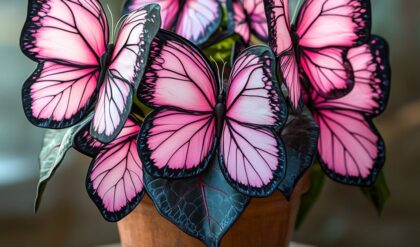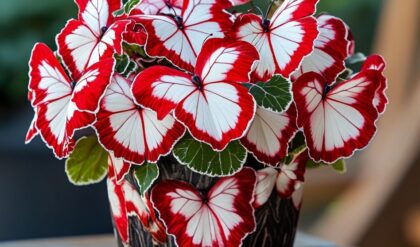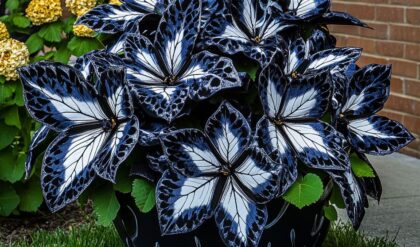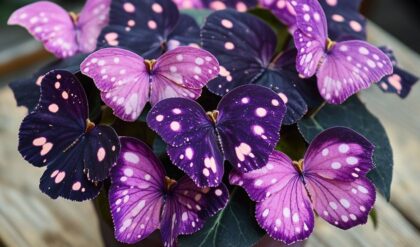As gardeners, we are constantly on the search for plants that not only enhance the aesthetic appeal of our outdoor spaces but also add a touch of tranquility and serenity. Enter the enchanting Blue Velvet Hostas, a perennial marvel that has captivated the hearts of green-thumbed enthusiasts worldwide. In this comprehensive guide, we’ll delve into the intricacies of cultivating these stunning plants, unlocking the secrets to their successful growth and transforming your garden into a serene oasis.

Understanding Hosta ‘Blue Velvet’
Hosta ‘Blue Velvet,’ also known as P. Aden 76, is a hybrid variety that has taken the gardening world by storm. Native to a range of hardy zones, these plants thrive in USDA hardiness zones 3a to 9b, making them a versatile choice for gardeners across a wide geographic spectrum.
At a mature height of around 20 inches, Blue Velvet Hostas boast breathtaking blue-green leaves that can lend depth and vibrancy to shaded areas of your garden. Their resilient nature allows them to flourish where many other plants may struggle, making them a favorite among both novice and experienced gardeners alike.
Ideal Growing Conditions
Light Requirements
These hostas are true connoisseurs of light, preferring dappled or indirect sunlight to mimic their natural habitat under the canopy of larger trees. While they can tolerate full shade, exposing them to the right amount of light can enhance their growth and leaf coloration, creating a captivating scene reminiscent of an impressionist painting, with soft shadows dancing across the ground.

Soil Composition
The soil in which Blue Velvet Hostas are planted serves as their foundation, and it’s crucial to get it right. Well-draining, humus-rich soil with a slightly acidic to neutral pH will provide the best environment for these perennials. Think of the soil as a nourishing feast that supports their growth, just as a painter prepares a canvas with the finest materials before unleashing their artistic vision.
Watering Needs
Hostas are connoisseurs of moisture, much like a painter delicately blending colors on a canvas. While they thrive in moist conditions, it’s essential to avoid waterlogging, as this can lead to root rot. Regular watering, especially during dry spells, ensures that their beautiful foliage remains lush and vibrant, showcasing the true vibrancy of their hue.
Caring for Blue Velvet Hostas
Maintaining the health and vigor of your Blue Velvet Hostas is essential to ensuring their long-term success in your garden. From fertilization to pest and disease management, each aspect of their care plays a crucial role in creating a lush and thriving landscape.

Fertilization
To encourage robust growth, feeding your Blue Velvet Hostas every 4-6 weeks during the growing season with a balanced fertilizer is a must. Think of this as giving them a boost of energy, much like athletes preparing for a competition. The right nutrients will ensure that the plants not only survive but thrive, allowing their mesmerizing leaves to shimmer in the sunlight.
Pest and Disease Management
While Blue Velvet Hostas are generally hardy, they are susceptible to pests such as slugs and snails, which can munch on their precious leaves. Implementing preventive measures, such as using copper barriers or organic pesticides, can protect your investment, ensuring that your garden looks pristine. Imagine creating a protective shield around these plants, a guardian against unwanted intruders.
Pruning and Dividing
Regular pruning and division can help maintain the health and appearance of your Blue Velvet Hostas. Removing any damaged or dead foliage can promote new growth and keep your plants looking their best. Additionally, dividing the clumps every 3-4 years can rejuvenate the plants and encourage even more vibrant displays.
Incorporating Blue Velvet Hostas into Your Garden Design
Hosta ‘Blue Velvet’ is a true star of the garden, and incorporating these enchanting plants into your landscape can transform ordinary spaces into extraordinary retreats. Their glossy leaves, especially when wet, resemble hand-painted porcelain, reflecting the beauty of nature and adding a touch of elegance to any setting.

Focal Points and Complementary Fillers
Blue Velvet Hostas can serve as striking focal points, drawing the eye and commanding attention in your garden. Alternatively, they can act as complementary fillers, adding depth and texture between flowering plants and creating a harmonious balance throughout your outdoor oasis.
Shade-Loving Companions
These hostas thrive in shaded areas, making them the perfect companions for other shade-loving plants. Consider pairing them with ferns, astilbes, or woodland wildflowers to create a serene, naturalistic setting that transports you to a lush, tranquil oasis.
Containers and Borders
Blue Velvet Hostas are also well-suited for container gardening, where their compact size and stunning foliage can be showcased in a more intimate setting. They also make excellent border plants, lining pathways or defining the edges of your garden beds with their captivating presence.
Conclusion
By understanding the nuances of growing and caring for Blue Velvet Hostas, you open the door to cultivating a thriving sanctuary of color and texture in your garden. As your hostas flourish, they’ll serve as a reminder of the joys of gardening—patience, care, and the beauty of nurturing life. Embrace the captivating allure of these perennial marvels and transform your outdoor space into a haven of serenity and enchantment.




